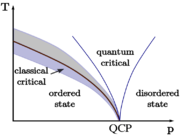
Condensed matter physics
Background to the schools Wikipedia
SOS believes education gives a better chance in life to children in the developing world too. SOS Children has looked after children in Africa for forty years. Can you help their work in Africa?
| Condensed matter physics |
|---|
 |
| Phases · Phase transition |
|
Phase phenomena
Order parameter · Phase transition
|
|
Electronic phases
Electronic band structure · Insulator · Mott insulator · Semiconductor · Semimetal · Conductor · Superconductor · Thermoelectric · Piezoelectric · Ferroelectric
|
|
Electronic phenomena
Quantum Hall effect · Spin Hall effect · Kondo effect
|
|
Magnetic phases
Diamagnet · Superdiamagnet
Paramagnet · Superparamagnet Ferromagnet · Antiferromagnet Metamagnet · Spin glass |
|
Quasiparticles
Phonon · Exciton · Plasmon
Polariton · Polaron · Magnon |
|
Soft matter
|
|
Scientists
Maxwell · Van der Waals · Debye · Bloch · Onsager · Mott · Peierls · Landau · Luttinger · Anderson · Bardeen · Cooper · Schrieffer · Josephson · Kohn · Kadanoff · Fisher
|
Condensed matter physics is the field of physics that deals with the macroscopic physical properties of matter. In particular, it is concerned with the "condensed" phases that appear whenever the number of constituents in a system is extremely large and the interactions between the constituents are strong. The most familiar examples of condensed phases are solids and liquids, which arise from the bonding and electromagnetic force between atoms. More exotic condensed phases include the superfluid and the Bose-Einstein condensate found in certain atomic systems at very low temperatures, the superconducting phase exhibited by conduction electrons in certain materials, and the ferromagnetic and antiferromagnetic phases of spins on atomic lattices.Condensed matter physics is that branch of physics which deals with the macroscopic physical properties of matter namely,solid and liquid,when their constituents are large and strong.
Condensed matter physics is by far the largest field of contemporary physics. Much progress has also been made in theoretical condensed matter physics. By one estimate, one third of all US physicists identify themselves as condensed matter physicists. Historically, condensed matter physics grew out of solid-state physics, which is now considered one of its main subfields. The term "condensed matter physics" was apparently coined by Philip Anderson and Volker Heine when they renamed their research group at Cavendish Laboratory - previously "solid-state theory" - in 1967. In 1978, the Division of Solid State Physics at the American Physical Society was renamed as the Division of Condensed Matter Physics. Condensed matter physics has a large overlap with chemistry, materials science, nanotechnology and engineering.
One of the reasons for calling the field "condensed matter physics" is that many of the concepts and techniques developed for studying solids actually apply to fluid systems. For instance, the conduction electrons in an electrical conductor form a type of quantum fluid with essentially the same properties as fluids made up of atoms. In fact, the phenomenon of superconductivity, in which the electrons condense into a new fluid phase in which they can flow without dissipation, is very closely analogous to the superfluid phase found in helium 3 at low temperatures.
